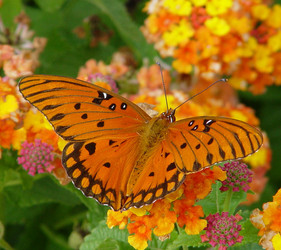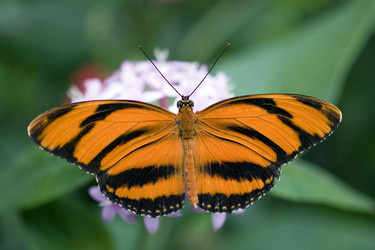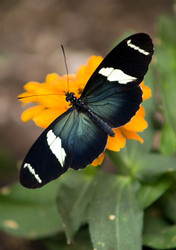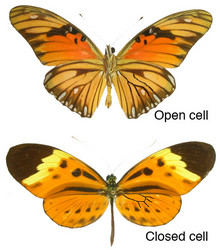Heliconiini
Passion-vine Butterflies
Margarita Beltran, Chris Jiggins, Niklas Wahlberg, and Andrew V. Z. Brower

This tree diagram shows the relationships between several groups of organisms.
The root of the current tree connects the organisms featured in this tree to their containing group and the rest of the Tree of Life. The basal branching point in the tree represents the ancestor of the other groups in the tree. This ancestor diversified over time into several descendent subgroups, which are represented as internal nodes and terminal taxa to the right.

You can click on the root to travel down the Tree of Life all the way to the root of all Life, and you can click on the names of descendent subgroups to travel up the Tree of Life all the way to individual species.
For more information on ToL tree formatting, please see Interpreting the Tree or Classification. To learn more about phylogenetic trees, please visit our Phylogenetic Biology pages.
close boxIntroduction
The Heliconiini or passion-vine butterflies, have played a key role in understanding evolutionary biology (e. g. mimicry) and ecology (e. g. mutualism between insects and plants), and it would be difficult to point a group of neotropical butterflies that have contributed more to our knowledge of the biological processes in the tropics (See Brown 1981 for review). These derived members of the subtribe Heliconiina have undergone rapid speciation and divergence, while also exhibiting impressive mimetic convergence in wing patterns.
Characteristics
Agraulis, Dione, Podotricha, Dryadula, and Dryas, termed the “basal” group by Brown (1981), have the wing venation of the discal cell of the hind wing open. These ‘open cell’ heliconiines are generally fast flying to avoid predation and are relatively edible. Also, their highly dispersive populations are associated with open sunny habitats, where they visit unspecialised butterfly-pollinated flowers with short corollas and large floral displays (e.g. Lantana).
The remaining genera Eueides, Neruda, and Heliconius (we here subsume the genus Laparus into Heliconius), termed the ‘advanced genera’ by Brown (1981), are the most diverse in terms of numbers of species. All of these possess a closed discal cell. Their wing patterns differ from the general nymphaline ground plan by great simplification and loss of many elements, as well as by the appearance of several novel mimetic patterns. The ‘closed-cell’ genera, Eueides, Neruda and Heliconius are relatively unpalatable, aposematic, and slow flying. Heliconius also feed on pollen from specialised butterfly-pollinated flowers such as Psiguria.
Discussion of Phylogenetic Relationships
In the last sixty years seven major studies have addressed the systematics of the passion-vine butterflies or Heliconiina (Brower, 1994a; Brower & Egan, 1997; Brown, 1981; Emsley, 1963; Emsley, 1965; Michener, 1942; Penz, 1999). These phylogenetic hypotheses are in conflict with one another, in particular with regard to the relationships among the genera Heliconius, Eueides, Neruda and Laparus, leading to disagreement over the origin of the derived behavioural trait, pollen feeding. The most recent attempt to resolve the phylogenetic relationships in the group, using molecular markers, showed that Heliconius is paraphyletic, with Laparus doris and Neruda falling within the genus (Beltran et al., 2006). This analysis was based on molecular sequence data for 3 mtDNA and 4 nuclear gene regions. The results would imply a single origin for pollen feeding but with a loss of the trait in Neruda. However different genes are not congruent in their placement of Neruda, such that statistical analysis implies that the traditional placement of Neruda as a sister group to Heliconius cannot be ruled out. Hence, we here place Neruda as sister to Heliconius, but subsume the monospecific genus Laparus into Heliconius (Heliconius doris).
The most recent morphological analysis of the group differs slightly from the tree presented here (Penz, 1999). Penz considered Neruda and Laparus to be sister genera to Euiedes, and Heliconius to be a sister to the other three genera. We would therefore caution that the relationships presented here might change given more data – either morphological analysis with more complete species sampling, or molecular data with more fast-evolving nuclear gene regions.
Note that we here consider the ‘passion vine butterflies’ as a tribe Heliconiini, although others have ranked them as a sub-tribe Heliconiina (Lamas, 2004).
References
Beltr?n M, Jiggins CD, Brower AVZ, Bermingham E, Mallet M. 2007. Do pollen feeding, pupal-mating and larval gregariousness have a single origin in Heliconius butterflies? Inferences from multilocus DNA sequence data. Biological Journal of the Linnean Society in press.
Brower AVZ. 1994. Phylogeny of Heliconius butterflies inferred from mitochondrial DNA sequences (Lepidoptera: Nymphalidae). Molecular Phylogenetics and Evolution 3: 159-174.
Brower AVZ, and Egan MG. 1997. Cladistics of Heliconius butterflies and relatives (Nymphalidae: Heliconiiti): the phylogenetic position of Eueides based on sequences from mtDNA and a nuclear gene. Proc. R. Soc. Lond. B 264: 969-977.
Brown KS, Jr. 1981. The biology of Heliconius and related genera. Ann. Rev. Entomol. 26: 427-456.
Emsley M. 1963. A morphological study of imagine Heliconiinae (Lep.: Nymphalidae) with a consideration of the evolutionary relationships within the group. Zoologica NY 48: 85-130.
Emsley MG. 1965. Speciation in Heliconius (Lep., Nymphalidae): morphology and geographic distribution. Zoologica, New York 50: 191-254.
Lamas G, Callaghan C, Casagrande MM, et al. 2004 Hesperioidea and Papilionoidea Association for Tropical Lepidoptera, Gainesville, Florida.
Mallet J, Gilbert LE. 1995. Why are there so many mimicry rings? Correlations between habitat, behaviour and mimicry in Heliconius butterflies. Biological Journal of the Linnean Society 55, 159-180.
Michener CD. 1942. A generic revision of the Heliconiinae (Lepidoptera, Nymphalidae). Amer. Mus. Novit. 1197: 1-8.
Penz CM. 1999. Higher level phylogeny for the passion-vine butterflies (Nymphalidae, Heliconiinae) based on early stage and adult morphology. Zoo. J. Linn. Soc. 127: 277-344.
Turner JRG. 1976. Adaptive radiation and convergence in subdivisions of the butterfly genus Heliconius (Lepidoptera: Nymphalidae). Zool. J. Linn. Soc. 58: 297-308.
Title Illustrations

| Scientific Name | Agraulis vanillae |
|---|---|
| Location | Mississippi, USA |
| Acknowledgements |
The copyright owner has released this image under the Attribution-NonCommercial-NoDerivs 2.0 Creative Commons license. source: flickr: Gulf Fritillary (Agraulis vanillae) |
| Specimen Condition | Live Specimen |
| Behavior | Feeding on it's primary host plant lantana. |
| Copyright | © 2003 Jimmy Smith |
| Scientific Name | Dryadula phaetusa |
|---|---|
| Location | captive at The Butterfly Place, Westford, Massachusetts, USA |
| Acknowledgements |
This image is
licensed under the Attribution-NonCommercial-ShareAlike 2.0 Creative Commons License. source: flickr: The_Butterfly_Place_20 |
| Specimen Condition | Live Specimen |
| Copyright | © 2006 Steven Erat |
| Scientific Name | Heliconius sara |
|---|---|
| Location | Portland Zoo, Portland, Oregon, USA |
| Acknowledgements |
The copyright owner has released this image under the Attribution 2.0 Creative Commons license. source: flickr: Small Blue Grecian Butterfly |
| Specimen Condition | Live Specimen |
| Copyright | © 2006 Stuart Seeger |
About This Page
Chris Jiggins

University of Cambridge
Niklas Wahlberg

Stockholm University, Stockholm, Sweden

Middle Tennessee State University, Murfreesboro, Tennessee, USA
Correspondence regarding this page should be directed to Margarita Beltran at , Chris Jiggins at , Niklas Wahlberg at , and Andrew V. Z. Brower at
Page copyright © 2006 , Chris Jiggins, Niklas Wahlberg, and
- First online 25 September 2006
- Content changed 18 February 2007
Citing this page:
Beltran, Margarita, Jiggins, Chris, Wahlberg, Niklas, and Brower, Andrew V. Z. 2007. Heliconiini . Passion-vine Butterflies. Version 18 February 2007 (under construction). http://tolweb.org/Heliconiini/70208/2007.02.18 in The Tree of Life Web Project, http://tolweb.org/












 Go to quick links
Go to quick search
Go to navigation for this section of the ToL site
Go to detailed links for the ToL site
Go to quick links
Go to quick search
Go to navigation for this section of the ToL site
Go to detailed links for the ToL site